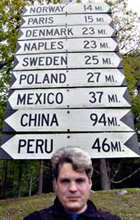Subscribe to the blog 
|
 |
 |
 |
 |
 |
Find a Flight Consider a Consolidator Rent a Car Pick a Railpass Book a Vacation Reserve a Room Get Gear |
|
||||||
|
The
Melandris and the Mud Angels I had dinner tonight at the apartment of Massimo and Vittoria Melandri in Florence. Their place was beautiful, a 14th-century building restructured in the 19th century, which is when they frescoed all the ceilings and the walls. Gorgeous. The ceiling paintings in the main salon where we dined were a bit obscured by soot, since (as explained Massmimo's 86-year-old mother, who lives on the top floor of the building and who joined us for dinner) two families were living in that small space during World War II, and as the electricity and gas were cut off, they cooked by building little fires in the middle of the room. Massimo can't clean them up properly since they aren't technically frescoes but rather paintings on the dry plaster, so to remove the soot would also remove the paint. Massimo had managed, however, to clean the 20th-century whitewash off the walls, which are (buon) frescoed with tromp l'oeil architectural elements. However, the surface of the plaster is microscopically pocked and flaking, so the frescoes are milky and faded looking, unless they get wet (a state that was demonstrated with the swipe of a damp rag), at which point the colors burst off the wall again in all their 19th-century splendor, only to fade slowly again as the plaster dried. Dinner was a penne casserole with ragu, followed by chicken breasts in a fresh porcini sauce, artichokes cooked in a bit of olive oil, and aldente cannellini beans, over which we drizzled a strong, deep green, perfectly opaque olive oil that Massimo had gathered and pressed just last Saturday at their small farm outside Casciano Val di Pesa, on the Chianti's western edge. To wash it all down we had the ruby red wine that Massimo makes himself — he doesn't use the communal press, but rather gathers the grapes from his few strings of vines, and has his own little press and aging facilities for making them into wine. Afterwards it was homemade crema gelato with a shot of whisky poured over it. During dinner, we first discussed some of Massimo's job, arranging art exhibits for the city, including a big one this past summer that placed all about town sculptures by a Bottero, famous for his paintings and huge bronzes of incredibly fat, but smooth and sort of minimalized, figures. Since the sculptures were displayed in public spaces it created some controversy — especially those on Piazza della Signoria, which is already full of famed ancient, Renaissance, and baroque statues. But in the end the exhibit was successful. Vittoria was even saying how a famous television personality and critic said good things about it, to which Massimo replied "Of course, he was paid to do so." But the mamma broke in with a phrase that makes sense only in a place like Italy: "Sara stato anche pagato, pero` non e stato comprato." (He may have been paid, but he wasn't bought.) Then they began regaling me with stories of the 1966 Arno flood, which inundated the city with a 20-foot wave after rains in the hills dumped 19 inches in less than 48 hours. The swollen river proved too much for the Florentine embankments. The Melandri's street, Via Fiesolana, runs north-south for two long blocks and then ends at another street, so the water rushed up it like a river, carrying along at first bicycles and motorini, then things like the newsstand from down at the corner, then entire cars, which came flying up the street at tremendous speed, borne by the raging waters, to smash into the wall at the top end of the street, where they stayed until the water began receding again after two days. At this point, the cars were carried by the water back down to the low end of the street, where for some reason (engine weight?) they all ended up tipped trunk-upward, with their front ends plunged deep into the ten feet of mud left behind and their back ends stuck up in the air, all lined up one after the other like dominoes frozen in the process of falling over. more >> |

